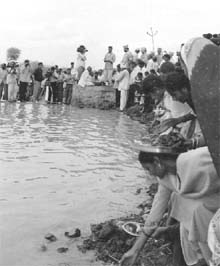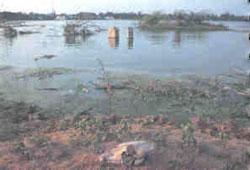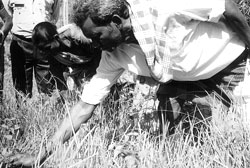
Caffeine could fight cancer
Research shows that the once dreaded caffeine can be used in the battle against certain cancers

Research shows that the once dreaded caffeine can be used in the battle against certain cancers
An unusual drought threatens agriculture in the Kashmir valley

Scientists are fighting the uzi fly, a parasite of the silkworm, with a wasp like insect that can help reduce that menace of the uzi fly, a parasite of the silkworm.

Farmers in Chhattisgarh blame the state for losses
Rehabilitation benefits have been provided to all 32,160 families affected by Sardar Sarovar project, who had opted to be rehabilitated in Madhya Pradesh. Out of total 37,975 families of MP affected by 138.68m final dam height of the project 5815 had to be rehabilitated in Gujarat state. Out of these 5815 families, rehabilitation of 5782 families had also been completed in Gujarat. Now only 33 families have to be rehabilitated. This was informed during a review of rehabilitation progress under Narmada Valley projects by vice chairman of Narmada Valley Development Authority Pradeep Bhargava here at Narmada Bhavan. Bhargava was chairing a meeting to review the rehabilitation status of three major projects of the valley namely-Sardar Sarovar Project (SSP), Inidra Sagar Project (ISP) and Omkareshwar (OSP). The Director Rehabilitation, RK Gupta informed that as much as 22438 residential plots had been allotted to the affected families in 88 rehabilitation sites developed for resettlement. There was option before displace families to take residential plot of 60x90 feet size free of cost or go for Rs 50,000 in lieu of plot. Using this option, 7806 families opted to take cash director rehabilitation informed. Bhargava reviewing the rehabilitation status of ISP and OSP directed officials to make frequent visits in the project affected areas so to address the problems of PAF's. He said that field officers should discharge rehabilitation work with full sensitivity besides keeping a strict vigil on encroachments in the areas vacated by PAF's. Bhargava also reviewed the work of shifting temples and monuments of archeological importance from the reservoir areas of these projects with Director Archeology Pramod Agarwal. He asked to prepare a time bound program to shift the remaining monuments before the onset of monsoon. He said that relocation sites of temples should be decided in consultation with local people and district Administration. Vice Chairman informed that a decision has been taken to cover project-affected families under various schemes of rural development. The officers have been put to specific training to make survey and prepare working plan for implementing various rural development and employment oriented schemes for displaced population of the Narmada Valley. He said that construction of irrigation field channels under Narmada Valley Projects would be undertaken in National Rural Employment Guaranty Scheme. It may be mentioned here that SSP would provide 57% of its total power generation to MP, which amounts to 826.5 MW. The state had already started drawing its power share.
Rehabilitation benefits have been provided to all 32,160 families affected by Sardar Sarovar project, who had opted to be rehabilitated in Madhya Pradesh. Out of total 37,975 families of MP affected by 138.68m final dam height of the project 5815 had to be rehabilitated in Gujarat state. Out of these 5815 families, rehabilitation of 5782 families had also been completed in Gujarat. Now only 33 families have to be rehabilitated. This was informed during a review of rehabilitation progress under Narmada Valley projects by vice chairman of Narmada Valley Development Authority Pradeep Bhargava here at Narmada Bhavan. Bhargava was chairing a meeting to review the rehabilitation status of three major projects of the valley namely-Sardar Sarovar Project (SSP), Indira Sagar Project (ISP) and Omkareshwar (OSP). The Director Rehabilitation, RK Gupta informed that as much as 22438 residential plots had been allotted to the affected families in 88 rehabilitation sites developed for resettlement. There was option before displace families to take residential plot of 60x90 feet size free of cost or go for Rs 50,000 in lieu of plot. Using this option, 7806 families opted to take cash director rehabilitation informed. Bhargava reviewing the rehabilitation status of ISP and OSP directed officials to make frequent visits in the project affected areas so to address the problems of PAF's. He said that field officers should discharge rehabilitation work with full sensitivity besides keeping a strict vigil on encroachments in the areas vacated by PAF's. Bhargava also reviewed the work of shifting temples and monuments of archaeological importance from the reservoir areas of these projects with Director Archaeology Pramod Agarwal. He asked to prepare a time bound program to shift the remaining monuments before the onset of monsoon. He said that relocation sites of temples should be decided in consultation with local people and district Administration. Vice Chairman informed that a decision has been taken to cover project-affected families under various schemes of rural development. The officers have been put to specific training to make survey and prepare working plan for implementing various rural development and employment oriented schemes for displaced population of the Narmada Valley. He said that construction of irrigation field channels under Narmada Valley Projects would be undertaken in National Rural Employment Guaranty Scheme. It may be mentioned here that SSP would provide 57% of its total power generation to MP, which amounts to 826.5 MW. The state had already started drawing its power share.
Although the State Government has declared some villages as "model village' from time to time its apathy towards them has raised a question mark about the Government's sincerity in making these villages as model villages. Jhaskal village under Satrasal GP in Dhubri district located in the far-western Part of the Indo-Bangla International border is a glaring example of underdevelopment. After 21 years of its declaration as a model village, Jhaskal area is still to see the light of development in communication, healthcare, education power supply, agriculture etc. Situated under Agomani Development block in Golakgani LAC, Jhaskal was formally declared as a model village and its foundation stone was laid on April -11, 1987 by the then Chief Minister of Asom Prafulla Kumar Mahanta. Though the people of the village are largely dependent on agriculture, they are deprived of the modern methods of agriculture including superior quality seeds, manure etc. Even the peasants do not get the right price for their produced goods. The education scenario in the village is also grim. The two ME schools established 22 years ago through public donations are yet to be provincialized by the Government. Great Jhaskal area has four Government LP Schools. These schools lack basic infrastructure like desks and benches. In comparison to students enrolment, there is also shortage of teachers. Three schools are still running with a single teacher each. In the name of healthcare, there is a sub-centre at Jhaskal but its lacks adequate nurse and medicines. As a result, for simple disease, the patients have to rush to Satrasal or Agomani for treatment. Road communication in the area is also very deplorable. In the monsoons due to lack of repair work, the village roads become muddy and waterlogged. Though there was a PWD road through the villages in the past, it was declared as a border road in 1985 at the time of fencing of barbed wire across the Indo-Bangla border resulting in a lot of troubles to the border people. Now, the villagers have to use the road as per the time and permission of the BSF. If not, they have to face action from them. Another grey area of this "model village' is power. The transformer remain out of order in majority of the days in the year making the villagers the worst sufferers. The village is also deprived of potable water. Though a Public health and Engineering scheme was launched at jhaskal Part -1, the people are deprived of its service. After six months of service, the scheme is lying abandoned for 19 to 20 years. It is worth mentioning here that several hundred bighas of lands in the area fall into India's side of the
<p>Kerala's 10,000 Solar Rooftop Programme is already in full swing with almost half (4700) rooftops signed up by mid-January 2013. Any Keralaite with 15 square meters of unshaded rooftop area can

The government's decision to set up a tribunal to decide compensation cases is being seen as an attempt to compromise the establishment of environment courts that would have much wider ambit.

Carbon dioxide trapped in pits built for tubewell motors in Haryana's green revolution districts have killed hundreds of farm workers. Scientists say overexploitation of the state's groundwater resources is indirectly responsible.

The heavenly idyll of a carefree people, happy to welcome tourists, gay in their carnival, peaceloving and gastronomic, is being devastated due to the avarice of miners

A Nepalese community that grows vegetables using traditional techniques is now succumbing to population pressures and rapid urbanisation.

Was the motel owned by a former environment minister's relatives really responsible for destroying the pristine banks of the Beas? The apex court thinks so, but question marks persist

This monsoon, the Raikas, traditional camel breeders in the Kumbalgarh Wild Life Sanctuary in Rajasthan's Pali district, will face an existential crisis again. It will be the third successive season that the pastoral community will have been banned from grazing their camels in Kumbalgarh.
A recent letter from a reader has disturbed me enormously. B P Radhakrishna, president of the Geological Society of India, in response to a story in Down To Earth about how drought was affecting

<b>Report card:</b> The government realised its failures and learned from the civil society. Despite cases of corruption and some errors in planning, the government programme is an achievement<br> <b>Success level:</b> Good

There's enough water in the tanks of Bangalore, Madras and Hyderabad, but more than enough corruption leaves the south high and dry

Six years ago, the Andhra Pradesh government decided to manage forests jointly with the people. This effort is breaking new ground in Naxalite infested areas of the state

The Ganga Mukti Andolan is endeavouring to free a stretch of the Ganga and the exploited fisherfolk that derive their livelihood from it from the clutches of landowners and mafia gangs.

Managing the conflict